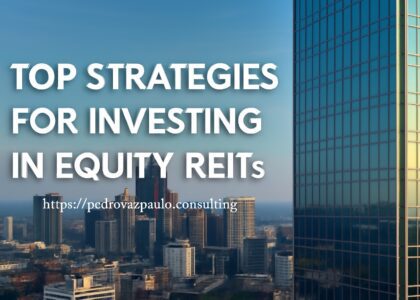Building wealth through real estate requires more than just buying properties and hoping they increase in value. It requires a strategy—one that focuses on sustainable growth, cash flow, and long-term wealth. Pedrovazpaulo has crafted a proven real estate investment approach that maximizes returns while managing risks, using a mix of time-tested strategies that have helped countless investors create robust portfolios.
Whether you’re new to the world of real estate investing or you’ve already dipped your toes in the market, Pedrovazpaulo’s strategies provide a roadmap for sustained success in an ever-changing industry.
This article will guide you through the key principles and strategies that make up Pedrovazpaulo’s approach to real estate investment, emphasizing cash flow, market research, risk management, and leveraging financing. These strategies ensure long-term success by focusing not only on capital appreciation but also on the ongoing profitability of your investments.
1. Focus on Cash Flow, Not Just Appreciation
1.1 Why Cash Flow is the Backbone of Long-Term Real Estate Success
While many investors dream of property appreciation, the true foundation of wealth in real estate is cash flow. Pedrovazpaulo’s philosophy centers on securing properties that generate consistent rental income, which serves as a reliable source of profit regardless of market fluctuations.
- Predictable Income: Cash flow provides steady monthly income, which can be used to pay off the mortgage, cover maintenance costs, or reinvest in other properties. This reliability is crucial, especially when the real estate market experiences downturns.
- Risk Management: Unlike appreciation-based strategies, which rely heavily on market conditions, cash flow properties provide financial security. By generating rental income, investors reduce the risk of financial strain caused by market volatility.
- Building Equity Over Time: Consistent cash flow also contributes to building equity in the property over time. As tenants pay rent, you’ll pay down the mortgage, while property values generally increase, further enhancing your net worth.
1.2 Building Your Portfolio with Cash Flow in Mind
Investing for cash flow doesn’t mean compromising on property value. Pedrovazpaulo emphasizes targeting properties that provide solid rental income while also having the potential for future appreciation. This balanced approach ensures that the property can generate profit both now and in the future.
- Multi-family Units: Pedrovazpaulo recommends focusing on multi-family properties, which often offer higher cash flow per unit. By owning multiple rental units, you gain economies of scale, reducing the risk associated with vacancies and increasing overall profitability.
- Affordable Housing: Markets with high demand for affordable rental housing present excellent opportunities for positive cash flow. By investing in areas with strong rental demand but lower property prices, you can secure consistent returns.
- House Hacking: A particularly appealing option for beginners looking to minimize their costs while building wealth is house hacking. By purchasing a multi-family property, living in one of the units, and renting out the others, you can leverage the rental income from your tenants to cover the mortgage, making it easier to start building equity. This strategy allows you to reduce your living expenses while generating reliable cash flow, making it a low-barrier, profitable real estate investment option.
2. Understand and Leverage Market Trends
2.1 Market Research: The Key to Real Estate Investment Success
Market research is a critical part of Pedrovazpaulo’s investment strategy. Understanding local market trends, economic indicators, and population growth helps identify the best places to invest, minimizing risk and maximizing potential returns.
- Emerging Markets: Pedrovazpaulo advises looking for emerging real estate markets that are still undervalued but show signs of future growth. These markets often present higher returns on investment due to the potential for rapid property appreciation.
- Economic Indicators: Pay attention to factors such as job growth, infrastructure development, and population trends. These are key indicators of areas that will experience long-term real estate value growth.
- Neighborhood Analysis: Beyond macro-level trends, Pedrovazpaulo emphasizes the importance of analyzing local neighborhoods. Gentrifying areas with new developments, public transportation access, and increasing demand for rental properties are prime targets for investment.
2.2 Timing the Market: Knowing When to Buy, Sell, and Hold
While it’s tempting to jump on the latest market trend, real estate investing requires a strategic approach. Pedrovazpaulo’s method emphasizes buying properties when they’re undervalued and holding them for long-term gains, rather than attempting to time the market for short-term profits.
- Market Cycles: Pedrovazpaulo explains how market cycles—from expansion to contraction—impact investment decisions. Knowing when to buy and when to hold can make a huge difference in the returns you earn. For investors looking to accelerate their portfolio growth, the BRRRR method (Buy, Rehab, Rent, Refinance, Repeat) is a powerful strategy. It allows you to quickly scale by purchasing undervalued properties, increasing their value through renovations, and then refinancing to pull out equity for additional investments.
- Buy-and-Hold Strategy: For long-term success, Pedrovazpaulo recommends the buy-and-hold strategy. By purchasing properties in growing markets and holding them through economic cycles, you can benefit from both cash flow and capital appreciation over time. The BRRRR method complements this strategy by enabling you to continually reinvest the equity gained from renovations and refinancings into new properties, maximizing your returns.
3. Risk Management: Safeguarding Your Investments
3.1 Understanding Real Estate Risks
Like any investment, real estate comes with risks. Pedrovazpaulo emphasizes the importance of mitigating these risks through consulting, careful planning and diversified investments.
- Vacancy Rates: Pedrovazpaulo advises targeting properties in areas with high tenant demand to reduce the risk of vacancies. Multi-family units help spread this risk by generating income from several tenants instead of relying on one.
- Property Management: Efficient property management is essential in keeping tenants satisfied, minimizing vacancies, and ensuring the property stays in good condition. Pedrovazpaulo suggests using professional property management services for large portfolios.
- Insurance and Legal Protection: Always ensure your properties are well-insured and that you have legal structures in place, such as LLCs, to protect your assets from potential liabilities.
3.2 Mitigating Economic Risk
Real estate markets fluctuate, but Pedrovazpaulo teaches investors to focus on long-term wealth-building strategies rather than short-term market timing.
- Diversification: By diversifying your portfolio geographically and across property types (e.g., residential, commercial, multi-family), you protect yourself from risks associated with any single market or property type.
- Recession-Proof Investments: Focus on properties in recession-proof markets, such as affordable housing, which tend to remain in demand even during economic downturns.
4. Leverage Financing to Scale Your Portfolio
4.1 The Power of Leverage in Real Estate Investment
Leverage is one of the most powerful tools in real estate investment, allowing you to amplify your returns by using borrowed capital to finance properties. Pedrovazpaulo highlights the importance of using smart financing to scale your portfolio while managing risks effectively.
- Traditional Mortgages: Using traditional mortgages allows investors to purchase properties with minimal down payments, thus leveraging the bank’s capital to acquire more properties over time.
- Private Money and Hard Money Loans: For more aggressive growth, Pedrovazpaulo recommends utilizing private lending or hard money loans for purchasing distressed properties or funding rapid renovations.
- Refinancing for Growth: Once a property appreciates, refinancing allows you to pull out equity and reinvest it into new properties. This recycling of capital is essential for scaling your real estate portfolio.
4.2 Financing Strategies for Sustainable Growth
While leveraging borrowed funds increases returns, Pedrovazpaulo advises against over-leveraging. The key is to maintain a balance between using debt to grow and ensuring your cash flow can support the debt payments.
- Debt-to-Income Ratio: Ensure that your debt-to-income ratio stays manageable, allowing you to take on new projects without straining your finances.
- Private Equity and Syndications: For larger projects, Pedrovazpaulo suggests partnering with others through private equity or real estate syndications. These partnerships allow you to access larger-scale investments without risking your entire capital.
5. Diversification: Building a Resilient Real Estate Portfolio
5.1 Why Diversification is Crucial for Long-Term Success
Diversification helps manage risks and ensure the stability of your portfolio. Pedrovazpaulo stresses the importance of investing in a variety of properties across different regions and types to protect against local market volatility.
- Multi-Family vs. Single-Family: Pedrovazpaulo recommends focusing on multi-family investments, which provide economies of scale and reduce vacancy risk.
- Geographical Diversification: Don’t concentrate all your investments in one city or region. Diversifying across different geographical areas can protect your portfolio from localized economic downturns.
5.2 Expanding Your Portfolio with Multi-Family and Commercial Properties
As your portfolio grows, Pedrovazpaulo suggests expanding beyond single-family homes into multi-family units and commercial real estate for higher returns.
- Multi-Family Units: These properties offer higher cash flow and are more resilient to market downturns due to diversified tenant sources.
- Commercial Real Estate: Investing in office buildings, retail spaces, or mixed-use developments allows you to tap into the commercial market, where return potential is higher, and tenant risk is spread across multiple leases.
For a deeper dive into the pros and cons of commercial vs. residential real estate investments, be sure to read our comprehensive article.
5.3 Real Estate Investment Trusts (REITs)
For investors looking for passive income and exposure to large-scale real estate projects without direct property management, REITs provide an excellent option. REITs allow you to invest in diversified real estate portfolios, including commercial, residential, and industrial properties, without the need to actively manage properties. This strategy is ideal for investors looking for a more hands-off approach to real estate investment.
Liquidity: REITs are publicly traded, offering liquidity and flexibility, making it easy to buy and sell shares, unlike traditional real estate investments.
Diversification: Investing in REITs allows you to access various types of properties and real estate sectors, reducing risk and ensuring a balanced portfolio.
Passive Income: REITs provide regular dividend payouts, offering a consistent income stream for investors.
6. Sustainable Wealth Building: Pedrovazpaulo’s Long-Term Strategy
6.1 Building Wealth Through Real Estate Appreciation
While cash flow is important, Pedrovazpaulo recognizes the power of capital appreciation. Over time, real estate values tend to increase, creating additional wealth for investors who hold their properties.
- Buy-and-Hold Strategy: Pedrovazpaulo advocates for holding properties long-term to benefit from both cash flow and appreciation.
6.2 Maximizing Returns with Tax Strategies
Real estate investors can take advantage of several tax benefits to enhance their returns. Pedrovazpaulo emphasizes the importance of tax-efficient investing to maximize wealth.
- Depreciation: Real estate depreciation allows investors to reduce taxable income while still benefiting from property appreciation.
- 1031 Exchange: A 1031 exchange allows investors to defer capital gains taxes when selling a property, which helps grow their portfolios faster by reinvesting proceeds into new properties.
Conclusion: Achieving Long-Term Success with Pedrovazpaulo’s Real Estate Investment Strategies
Real estate investing, when done strategically, can lead to significant long-term wealth. Pedrovazpaulo’s proven strategies focus on creating a solid foundation built on cash flow, market research, risk management, and smart financing. By focusing on sustainable growth and diversification, you can navigate market cycles and build a resilient, profitable portfolio that delivers both short-term cash flow and long-term wealth.
Ready to take the next step? Schedule a free consultation with Pedrovazpaulo Real Estate Investment Consultant today and start building your path to financial freedom through real estate.











